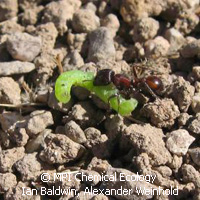Succulent secretions prove fatal for caterpillars
As tempting as the sweet secretions of wild tobacco (Nicotiana attenuata) are, baby caterpillars should think about eating something else. New research from Germany shows that consumption of the secretions released by the plant's trichomes (hair-like projections on leaves) trigger side effects that leave these freshly hatched insects in danger: their bodies and frass (faeces) develop a distinctive body odour that attracts ants, putting them in grave danger. The study is presented in the journal Proceedings of the National Academy of Sciences (PNAS). Trichomes are used by plants to defend themselves against their prey. And the trichomes of wild tobacco, which is commonly referred to as coyote tobacco, contain primarily acyl sugars that are composed of the common sugar, sucrose. These sugars are bound to branched chain aliphatic acids, which, say experts, are compounds that give baby vomit its distinctive odour. Researchers from the Max Planck Institute for Chemical Ecology in Germany have discovered that when the hungry freshly hatched caterpillars devour the sweet secretions of coyote tobacco, ants launch into action. The colony-loving insects recognise the caterpillar's body odour and use the aliphatic acids excreted by the aspiring butterfly to find the larvae on the plants and carry them back to their nests to feed their young and co-workers. So acyl sugars are used by the coyote plant not only to keep prey at bay but also to tag insatiable caterpillars and make it so much easier for ants to find them. The team points out that the striking features of animals can be fateful, in particular because they can be spotted by their enemies much more quickly. Meanwhile the larvae of the silver-spotted skipper, Epargyreus clarus, are known for their thoroughness in removing faeces from their shelter in order to eradicate any foul smells and attract potential prey. Ian Baldwin of the Max Planck Institute for Chemical Ecology and colleagues recently discovered that other species of plant use the predators' preferences to their advantage. The oral secretions of the tobacco hornworm (Manduca sexta) larvae have a substance that triggers the transformation of green leaf volatiles into dangerous attractants, something that does not bode well for the caterpillars. The scientists found that the freshly hatched tobacco hornworm larvae, along with two Spodoptera species, consumed the hairs on the leaves as well as their contents. But the odour of the larvae changed after they digested the secretions; chemical analyses showed that these aliphatic acids came from the trichomes' acyl sugars that were consumed by the larvae. 'We were actually pretty sure that the volatile fatty acids would attract predators like bugs of the Geocoris genus, which would feed on the Manduca larvae and eggs,' Dr Baldwin explains. They found that predators were also able to find tiny leaf-perched larvae that were also perfumed with branched-chain aliphatic acids. The team believes that coyote tobacco plants deceive their enemies by offering delicious sugar molecules, giving themselves the protection they need. Future work will focus on determining whether this molecular strategy is an 'indirect defence' from an ecological perspective.For more information, please visit: Max Planck Institute for Chemical Ecology:http://www.ice.mpg.de/ext/PNAS:http://www.pnas.org/
Countries
Germany



